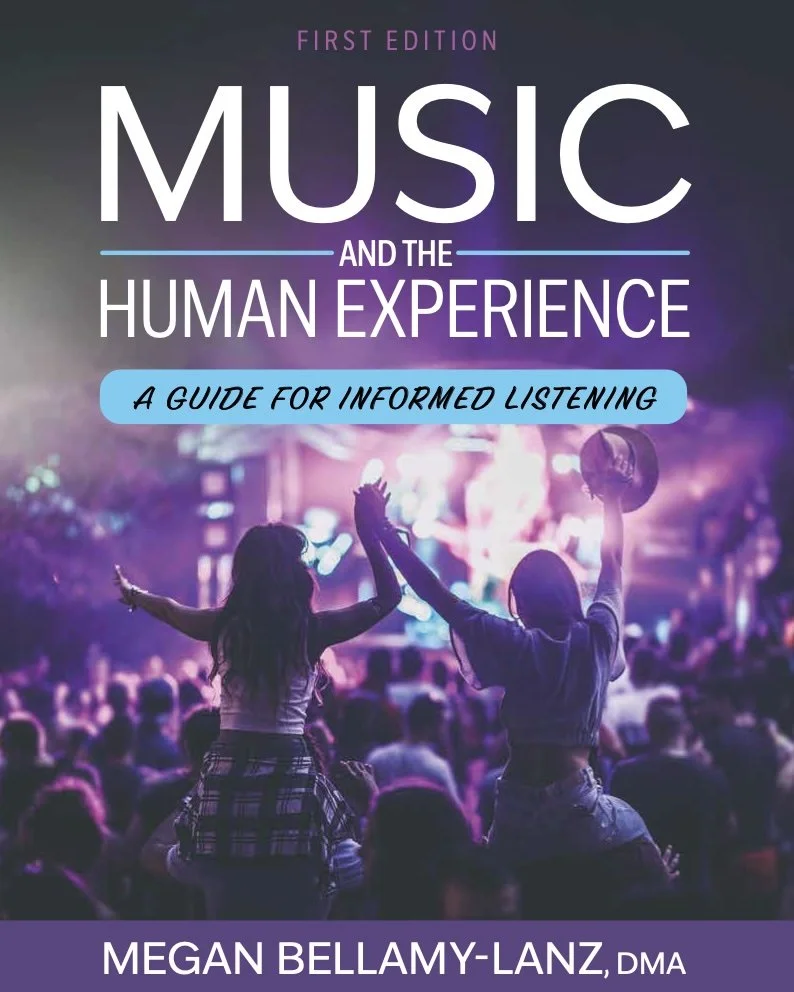
Introducing a new text for modern
Music Appreciation students.
Modern, diverse, user-friendly, and ready to be incorporated into your campus LMS for both synchronous and asynchronous instruction. Contains formative assessments, ungraded review activities, and summative unit quizzes.
View on the publisher’s website by clicking here!
Available for course adoption!
Music and the Human Experience:
A Guide for Informed Listening
Table of Contents
-
What is Music?
Instrument Families
Foundational Terminology
The Live Music Experience
-
Memory and Repetition
Structure
Pushing Boundaries
-
Music that Makes Us Move
Music for Celebration
Entertainment Experiences
-
Community Identity and Bonding
Sacred and Spiritual Expression
Music for Change
-
Mourning and Catharsis
Amplifying and Neutralizing Emotions
-
20th Century New Ideas
20th and 21st Century creativity
Music in solation
Content questions or other inquiries? Click below to send a message and I will respond to your inquiry ASAP. You may also request course learning objectives and a sample syllabus.
A humanist approach
Introducing Music and the Human Experience: A Gude for Informed Listening by Dr. Megan Bellamy-Lanz
Music Appreciation has been a standard curricular offering since the early 20th century. While the overall goal has been to provide students with tools to understand not only what they are hearing but also the “story” behind an example, many of our popular textbooks still provide material in a chronological (historical) way. Instead of guiding students through a chronology of musical developments, which often causes books to be written from a Western-centric lens, this book’s content is organized by function. Students are introduced to a variety of uses for music and are provided with formal terminology and social and psychological theories to encourage them to consider the ways in which they use music in their everyday lives. In this way, “appreciating” is not only a reflection of knowing where something comes from, but also being able to choose what we listen to with intent and understanding of how it serves us. The text uses Spotify® to organize playlists and examples.
This publication addresses what I have observed to be a gap in our musical education system. For over half a century, universities in the United States have taught Music Appreciation from a Western-centric approach. This idea is now outdated, and we deserve a new textbook that addresses music not in a primarily historical sense, as has been the case for decades (with a few exceptions).
Drawing upon the concepts of music psychology to guide the content organization, this book prioritizes the concept of music as a product of the culture in which it is created and how it reflects the human experience in general. The chapters draw examples from around the globe and show how music can be used to create a sense of identity, to express, to mourn, to fight for social change, and to bring communities together. This is the type of text that should make every student feel seen, important, and included.
If you are interested in adopting this text for instruction at your institution, please click here.
View this book in Cognella’s catalog by clicking here. The First Edition is available for course adoption!
Download this poster, containing information about this book’s approach. For Course Learning Objectives and a sample syllabus, email megan.bellamy-lanz@colostate.edu.



